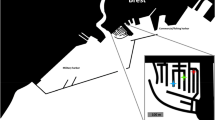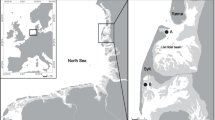Abstract
Non-indigenous ascidians are known to significantly alter the structure and composition of benthic communities and adversely affect shellfish aquaculture by fouling both the cultured species and the infrastructure. The ability of these species to persist in new locations and their current and potential distributions are dependent upon physiological tolerances to environmental factors and biotic resistance to competition and predation. Despite significant data on global invasion patterns, potential biotic resistance to non-indigenous ascidians is poorly understood. We identified potential predators of four non-indigenous ascidians (Styela clava, Botryllus schlosseri, Botrylloides violaceus, and Didemnum vexillum) in British Columbia (BC), Canada in order to: (1) assess the potential for biotic interference to limit the establishment and/or spread of these ascidian species in BC, and (2) identify candidate species to be used as ascidian biofouling control agents in shellfish aquaculture. Using a series of single- and multiple-choice laboratory experiments, potential benthic predators (including various species of molluscs, echinoderms, and arthropods) were offered non-indigenous ascidians as prey. The sea urchins Strongylocentrotus droebachiensis and Strongylocentrotus franciscanus, the sea stars Dermasterias imbricata and Evasterias troschelii, the nudibranch Hermissenda crassicornis, and the crabs Cancer productus and Carcinus maenas were found to consume one or more species of non-indigenous ascidians in single-choice experiments. However, when provided a choice, all predators chose their respective preferred food over ascidians. Thus, predation alone is unlikely to prevent large-scale establishment and spread of non-indigenous ascidians in BC, but it may have the potential to significantly reduce localized populations of ascidians. Green sea urchins, S. droebachiensis, were found to be efficient grazers of all four ascidian species, consuming 12.7 ± 5.14 cm2 (mean ± SD) of adult B. violaceus over a 3-day period, 15 ± 3.7 juvenile colonies of B. violaceus over a 2-day period, and 63 ± 28.8 juvenile colonies of B. schlosseri over a 2-day period. Using sea urchins as biological control organisms may significantly reduce ascidian fouling in shellfish aquaculture.


Similar content being viewed by others
References
Brunetti R, Beghi L, Bressan M, Marin MG (1980) Combined effects of temperature and salinity on colonies of Botryllus schlosseri and Botrylloides leachi (Ascidiacea) from the Venetian Lagoon. Mar Ecol Prog Ser 2:303–314. doi:https://doi.org/10.3354/meps002303
Carver CE, Chisholm A, Mallet AL (2003) Strategies to mitigate the impact of Ciona intestinalis (L.) biofouling on shellfish production. J Shellfish Res 22:621–631
Cayer D, MacNeil M, Bagnall AG (1999) Tunicate fouling in Nova Scotia aquaculture: a new development. J Shellfish Res 18:327
Connell JH (1983) On the prevalence and relative importance of interspecific competition: evidence from field experiments. Am Nat 122:661–696. doi:https://doi.org/10.1086/284165
Dijkstra J, Harris LG, Westerman E (2007) Distribution and long-term temporal patterns of four invasive colonial ascidians in the Gulf of Maine. J Exp Mar Biol Ecol 342:61–68. doi:https://doi.org/10.1016/j.jembe.2006.10.015
Enright C, Krailo D, Staples L, Smith M, Vaughan C, Ward D, Gaul P, Borgese E (1983) Biological control of fouling algae in oyster aquaculture. J Shellfish Res 3:41–44
Epelbaum A, Herborg L-M, Therriault TW, Pearce CM (2009a) Temperature and salinity effects on growth, survival, reproduction, and potential distribution of two non-indigenous botryllid ascidians in British Columbia. J Exp Mar Biol Ecol 369:43–52. doi:https://doi.org/10.1016/j.jembe.2008.10.028
Epelbaum A, Therriault TW, Paulson A, Pearce CM (2009b) Botryllid tunicates: culture techniques and experimental procedures. Aquat Invasion 4:111–120. doi:https://doi.org/10.3391/ai.2009.4.1.12
Fretter V (1951) Some observations on the British cypraeids. Proc Malacol Soc Lond 29:14–20
Hintze J (2001) NCSS and PASS. Number Cruncher Statistical Systems, Kaysville. Available at: www.ncss.com
Karayucel S (1997) Mussel culture in Scotland. World Aquac 28:4–10
Kashenko SD (1996) Effects of desalination on the larval settlement and metamorphosis of the ascidian Styela clava. Biol Morya (Vladivost) 2:174–178
Lambert G (2002) Nonindigenous ascidians in tropical waters. Pac Sci 56:291–298. doi:https://doi.org/10.1353/psc.2002.0026
Lambert G (2007) Invasive sea squirts: a growing global problem. J Exp Mar Biol Ecol 342:3–4. doi:https://doi.org/10.1016/j.jembe.2006.10.009
Lambert G (2009) Adventures of a sea squirt sleuth: the remarkable story of Didemnum vexillum, a global ascidian invader. Aquat Invasion 4:5–28. doi:https://doi.org/10.3391/ai.2009.4.1.2
Lambert CC, Lambert G (1998) Non-indigenous ascidians in southern California harbors and marinas. Mar Biol (Berl) 130:675–688. doi:https://doi.org/10.1007/s002270050289
Lambert CC, Lambert G (2003) Persistence and differential distribution of non-indigenous ascidians in harbors of the Southern California Bight. Mar Ecol Prog Ser 259:145–161. doi:https://doi.org/10.3354/meps259145
LeBlanc N, Davidson J, Tremblay R, McNiven M, Landry T (2007) The effect of anti-fouling treatments for the clubbed tunicate on the blue mussel, Mytilus edulis. Aquaculture 264:205–213. doi:https://doi.org/10.1016/j.aquaculture.2006.12.027
Lindquist N, Hay ME, Fenical W (1992) Defense of ascidians and their conspicuous larvae: adult vs. larval chemical defenses. Ecol Monogr 62:547–568. doi:https://doi.org/10.2307/2937316
Lodeiros C, Garcia N (2004) The use of sea urchins to control fouling during suspended culture of bivalves. Aquaculture 231:293–298. doi:https://doi.org/10.1016/j.aquaculture.2003.10.022
Lopez-Legentil S, Turon X, Schupp P (2006) Chemical and physical defenses against predators in Cystodytes (Ascidiacea). J Exp Mar Biol Ecol 332:27–36. doi:https://doi.org/10.1016/j.jembe.2005.11.002
McCarthy A, Osman RW, Whitlatch RB (2007) Effects of temperature on growth rates of colonial ascidians: a comparison of Didemnum sp. to Botryllus schlosseri and Botrylloides violaceus. J Exp Mar Biol Ecol 342:172–174. doi:https://doi.org/10.1016/j.jembe.2006.10.036
Millar RH (1971) The biology of ascidians. Adv Mar Biol 9:1–100. doi:https://doi.org/10.1016/S0065-2881(08)60341-7
Osman RW, Whitlatch RB (1995a) Influence of resident adults on larval settlement: a comparison to settlement. J Exp Mar Biol Ecol 190:169–198. doi:https://doi.org/10.1016/0022-0981(95)00035-P
Osman RW, Whitlatch RB (1995b) Ecological factors controlling the successful invasion of three species of ascidians into marine subtidal habitats in New England. In: Balcom NC (ed) Proceedings of the northeast conference on non-indigenous aquatic nuisance species, 25 January 1997. Publication no: CT-SG-95-04. Connecticut Sea Grant College Program, Cromwell, pp 49–60
Osman RW, Whitlatch RB (1999) Ecological interaction of invading ascidians within epifaunal communities of southern New England. In: Pederson J (ed) Marine bioinvasions: proceedings of the first national conference, January 24–27, 1999. Sea Grant College Program, Massachusetts Institute of Technology, Cambridge, pp 164–174
Osman RW, Whitlatch RB (2004) The control of the development of a marine benthic community by predation on recruits. J Exp Mar Biol Ecol 311:117–145. doi:https://doi.org/10.1016/j.jembe.2004.05.001
Pisut DP, Pawlik JR (2002) Anti-predatory chemical defenses of ascidians: secondary metabolites or inorganic acids? J Exp Mar Biol Ecol 270:203–214. doi:https://doi.org/10.1016/S0022-0981(02)00023-0
Ross KA, Thorpe JP, Brand AR (2004) Biological control of fouling in suspended scallop cultivation. Aquaculture 229:99–116. doi:https://doi.org/10.1016/S0044-8486(03)00328-4
Sebens KP (1999) Marine bioinvasions in the rocky subtidal zone (Massachusetts 1977–1998). In: Pederson J (ed) Marine bioinvasions: proceedings of the first national conference, January 24–27, 1999. Sea Grant College Program, Massachusetts Institute of Technology, Cambridge, p 414
Singer MC, Thomas CD, Parmesan C (1993) Rapid human-induced evolution of insect–host associations. Nature 366:681–683. doi:https://doi.org/10.1038/366681a0
Stachowicz JJ, Fried H, Osman RW, Whitlatch RB (2002) Biodiversity, invasion resistance, and marine ecosystem function: reconciling patterns and processes. Ecology 83:2575–2590
Stefaniak L, Lambert G, Gittenberger A, Zhang H, Lin S, Whitlatch RB (2009) Genetic conspecificity of the worldwide populations of Didemnum vexillum Kott, 2002. Aquat Invasion 4:29–44. doi:https://doi.org/10.3391/ai.2009.4.1.3
Stoecker D (1980) Chemical defenses of ascidians against predators. Ecology 61:1327–1334. doi:https://doi.org/10.2307/1939041
Tabashnik BE (1983) Host range evolution: the shift from native legume hosts to alfalfa by the butterfly, Colias philodice eriphyle. Evolution 37:150–162. doi:https://doi.org/10.2307/2408183
Uribe E, Etchepare I (2002) Effects of biofouling by Ciona intestinalis on suspended culture of Argopecten purpuratus in Bahia Inglesa, Chile. Bull Aquac Assoc Can 102:93–94
Valentine PC, Collie JS, Reid RN, Asch RG, Guida VG, Blackwood DS (2007a) The occurrence of the colonial ascidian Didemnum sp. on Georges Bank gravel habitat—ecological observations and potential effects on groundfish and scallop fisheries. J Exp Mar Biol Ecol 342:179–181. doi:https://doi.org/10.1016/j.jembe.2006.10.038
Valentine PC, Carman MR, Blackwood DS, Heffron EJ (2007b) Ecological observations on the colonial ascidian Didemnum sp. in a New England tide pool habitat. J Exp Mar Biol Ecol 342:109–121. doi:https://doi.org/10.1016/j.jembe.2006.10.021
Waddell BJ, Perry RI (2007) Survey results of green sea urchin (Strongylocentrotus droebachiensis) populations in Queen Charlotte Strait, British Columbia, October 2006. Can Tech Rep Fish Aquat Sci 2742:47
Whitlatch R, Osman R, Frese A, Malatesta R, Mitchell P, Sedgewick L (1995) The ecology of two introduced marine ascidians and their effects on epifaunal organisms in Long Island Sound. In: Balcom NC (ed) Proceedings of the northeast conference on non-indigenous aquatic nuisance species, 25 January 1997. Publication no: CT-SG-95-04. Connecticut Sea Grant College Program, Cromwell, pp 29–48
Yamaguchi M (1975) Growth and reproductive cycles of the marine fouling ascidians Ciona intestinalis, Styela plicata, Botrylloides violaceus, and Leptoclinum mitsukurii at Aburatsubo-Moroiso Inlet (Central Japan). Mar Biol (Berl) 29:253–259. doi:https://doi.org/10.1007/BF00391851
Young CM (1986) Defenses and refuges: alternative mechanisms of coexistence between a predatory gastropod and its ascidian prey. Mar Biol (Berl) 91:513–522. doi:https://doi.org/10.1007/BF00392603
Acknowledgments
We thank J. Blackburn, L. Keddy, and R. Marshall (Fisheries and Oceans Canada) for their assistance in various aspects of the experiments, as well as Marine Biology editors and reviewers for their helpful suggestions that improved the manuscript. Support for the project was provided by funds from the Aquatic Invasive Species program of Fisheries and Oceans Canada. A. Epelbaum was funded through the Visiting Fellowship in Canadian Governmental Laboratories program of the Natural Sciences and Engineering Research Council of Canada (NSERC). A. Paulson and D. Barker were funded by Undergraduate Student Research Awards and a Discovery Grant (to C. Pearce) provided by NSERC. All experiments comply with the current laws of Canada.
Author information
Authors and Affiliations
Corresponding author
Additional information
Communicated by P. Kraufvelin.
Rights and permissions
About this article
Cite this article
Epelbaum, A., Pearce, C.M., Barker, D.J. et al. Susceptibility of non-indigenous ascidian species in British Columbia (Canada) to invertebrate predation. Mar Biol 156, 1311–1320 (2009). https://doi.org/10.1007/s00227-009-1172-7
Received:
Accepted:
Published:
Issue Date:
DOI: https://doi.org/10.1007/s00227-009-1172-7




